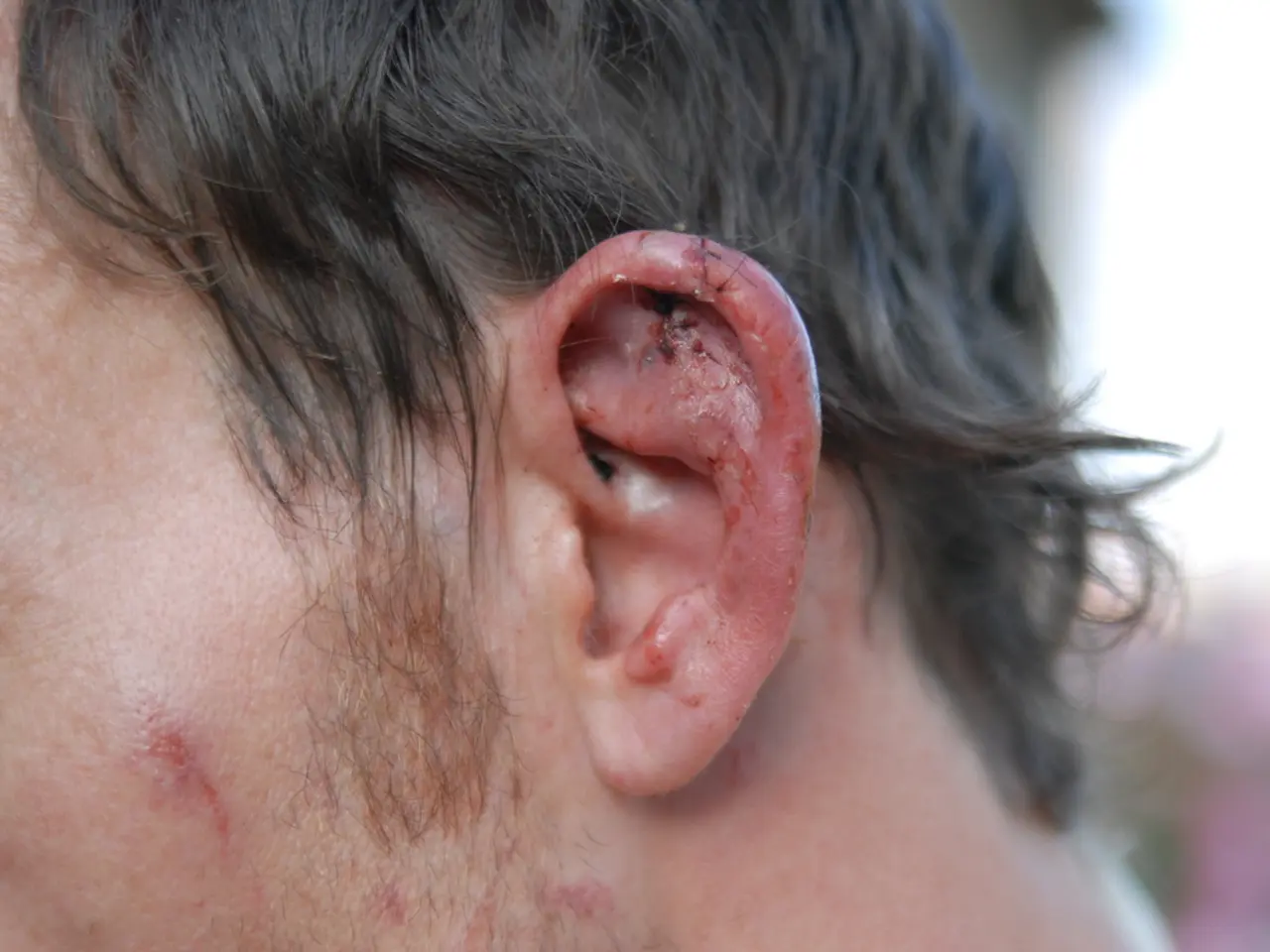Deep Vein Thrombosis and Pulmonary Embolism Symptoms: A Look at Blood Clot Indicators
In the human body, blood clots play a crucial role in stopping bleeding when we are injured. However, when they form due to disruptions in normal bodily systems, they can lead to serious health issues such as deep vein thrombosis (DVT) and pulmonary embolism.
DVT, characterised by a blood clot in a deep vein, usually in the leg, pelvis, or arm, can cause symptoms such as swelling, pain, or tenderness in the affected limb, along with skin warmth and discoloration. If left untreated, these clots can travel to the lungs, causing a pulmonary embolism.
A pulmonary embolism occurs when a blood clot travels from a deep vein into a lung. Symptoms of a pulmonary embolism can include difficulty breathing or sudden shortness of breath, chest pain that worsens with deep breathing or lying down, coughing, sometimes with blood, rapid or irregular heartbeat, lightheadedness or fainting, and other serious symptoms. This condition requires emergency medical attention.
Doctors treat pulmonary embolism using medications that dissolve blood clots, called thrombolytics, and medicines that prevent blood clotting, called anticoagulants. In severe cases, surgical removal of the clot may be necessary.
Blood clots in the chest can also lead to heart problems. An arterial clot around the heart can cause a heart attack, with symptoms such as chest pain or pressure, pain radiating to the arm, neck, or jaw, shortness of breath, sweating, nausea, or fainting. Heart attacks require immediate medical attention.
Blood clots in the brain can lead to ischemic stroke, causing symptoms such as sudden numbness or weakness, especially on one side of the body, sudden confusion, trouble speaking or understanding speech, sudden vision problems in one or both eyes, sudden difficulty walking, dizziness, loss of balance or coordination, and a severe headache with no known cause. Strokes are also medical emergencies.
Preventing blood clots involves maintaining a moderate weight, avoiding a sedentary lifestyle, using compression stockings or anticoagulants to prevent clots, staying hydrated, moving the lower legs, and getting up for a walk while traveling. Risk factors for blood clots include recent surgery, recent hospitalization, a family history of blood clots, slow blood flow due to limited movement, increased estrogen from birth control pills, menopause medications, or pregnancies, damage to the vein linings due to fractures, muscle trauma, or long-term vascular conditions, heart disease, lung disease, cancer and some cancer treatments, inflammatory bowel disease, inherited clotting disorders, and other medical conditions.
Early diagnosis and treatment of blood clots can help prevent complications and death. If you experience any symptoms associated with blood clots, seek immediate medical attention. Recognising and addressing these issues early can make a significant difference in managing and treating them effectively.
[1] American Heart Association. (2021). What Are the Symptoms of Deep Vein Thrombosis (DVT)? [online] Available at: https://www.heart.org/en/health-topics/stroke/warning-signs-of-stroke/what-are-the-symptoms-of-deep-vein-thrombosis-dvt
[2] Mayo Clinic. (2021). Pulmonary embolism: Symptoms and causes. [online] Available at: https://www.mayoclinic.org/diseases-conditions/pulmonary-embolism/symptoms-causes/syc-20372404
[3] National Heart, Lung, and Blood Institute. (2021). What Are the Symptoms of Blood Clots? [online] Available at: https://www.nhlbi.nih.gov/health-topics/blood-clots#symptoms
- Blood clots, forming due to disruptions in normal bodily systems, can lead to serious health issues like DVT.
- DVT, a blood clot in a deep vein, can cause swelling, pain, or tenderness in the affected limb.
- Untreated DVT clots can travel to the lungs, causing a pulmonary embolism.
- Symptoms of a pulmonary embolism include difficulty breathing, chest pain, coughing (sometimes with blood), rapid or irregular heartbeat, and lightheadedness or fainting.
- Doctors treat pulmonary embolism using thrombolytics and anticoagulants, with surgery being a last resort in severe cases.
- Blood clots in the chest can also lead to heart attacks, characterized by chest pain or pressure, arm, neck, or jaw pain.
- A heart attack requires immediate medical attention to prevent further damage.
- Blood clots in the brain can lead to ischemic stroke, causing sudden numbness, confusion, vision problems, difficulty walking, dizziness, loss of balance, and severe headache.
- Strokes are medical emergencies that require immediate attention.
- Preventing blood clots involves maintaining a moderate weight, avoiding a sedentary lifestyle, using compression stockings or anticoagulants.
- Staying hydrated, moving the lower legs, getting up for a walk while traveling can also help prevent blood clots.
- Factors increasing the risk of blood clots include recent surgery, recent hospitalization, family history, slow blood flow, increased estrogen, damage to vein linings, heart disease, lung disease, cancer, inflammatory bowel disease, inherited clotting disorders, and other medical conditions.
- Early diagnosis and treatment of blood clots are crucial to prevent complications and death.
- If you experience any symptoms associated with blood clots, seek immediate medical attention.
- Recognising and addressing these issues early can make a significant difference in managing and treating them effectively.
- For more information on DVT symptoms, visit the American Heart Association website.
- To learn about pulmonary embolism symptoms and causes, check out Mayo Clinic's resource.
- For comprehensive insights on blood clot symptoms, consult the National Heart, Lung, and Blood Institute.
- Regular health check-ups, especially for those with a family history of blood clots, are essential to ensure early detection and treatment.
- Incorporating fitness and exercise into your lifestyle can reduce the risk of chronic diseases associated with blood clots.
- Maintaining a balanced diet and practicing good nutrition is also important for overall health and wellness.
- Skin care, mental health, sexual health, and men's health should all be prioritized for comprehensive wellness.
- Aging brings unique health challenges, with conditions like asthma, cancer, respiratory conditions, digestive health, and neurological disorders needing special attention. For women, concerns like cervical health, pregnancy, and parenting are crucial aspects of their health journey. Men can focus on prostate health, while all should pay attention to cardiovascular health, weight management, and eye, hearing, and skin conditions. Therapies and treatments, such as CBD for pain relief and sports rehabilitation, can play a significant role in managing various health issues.




